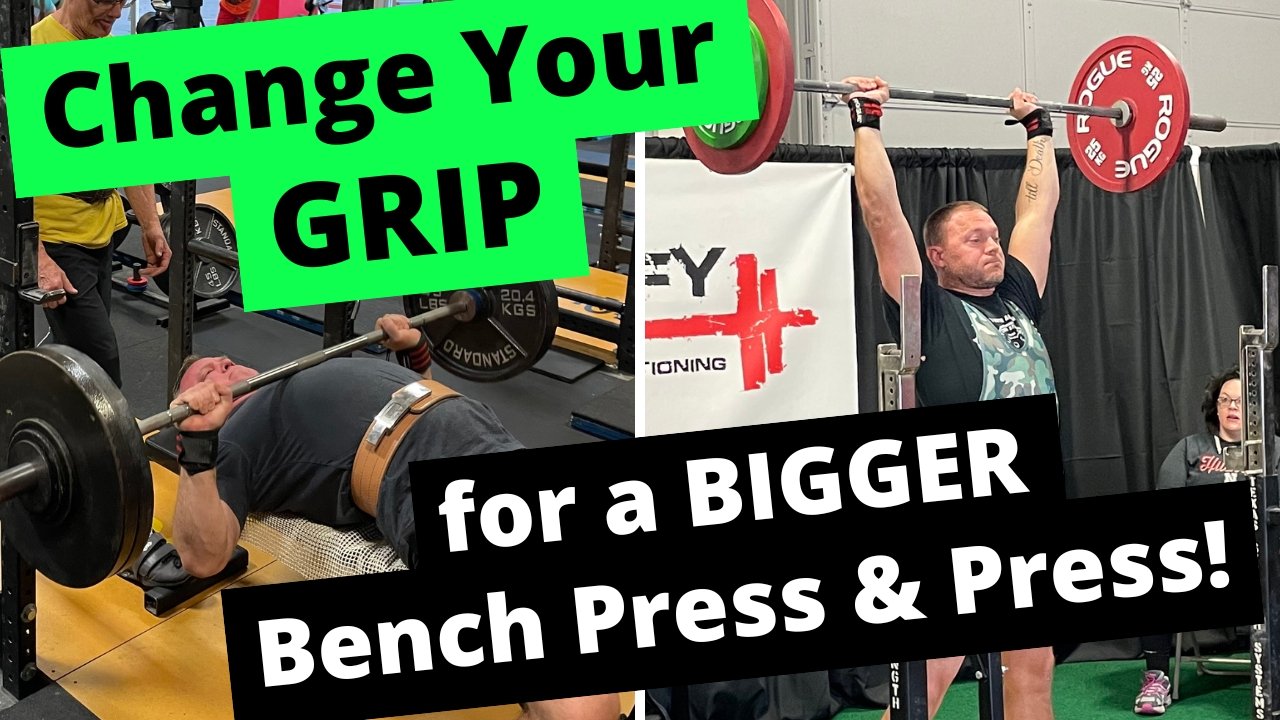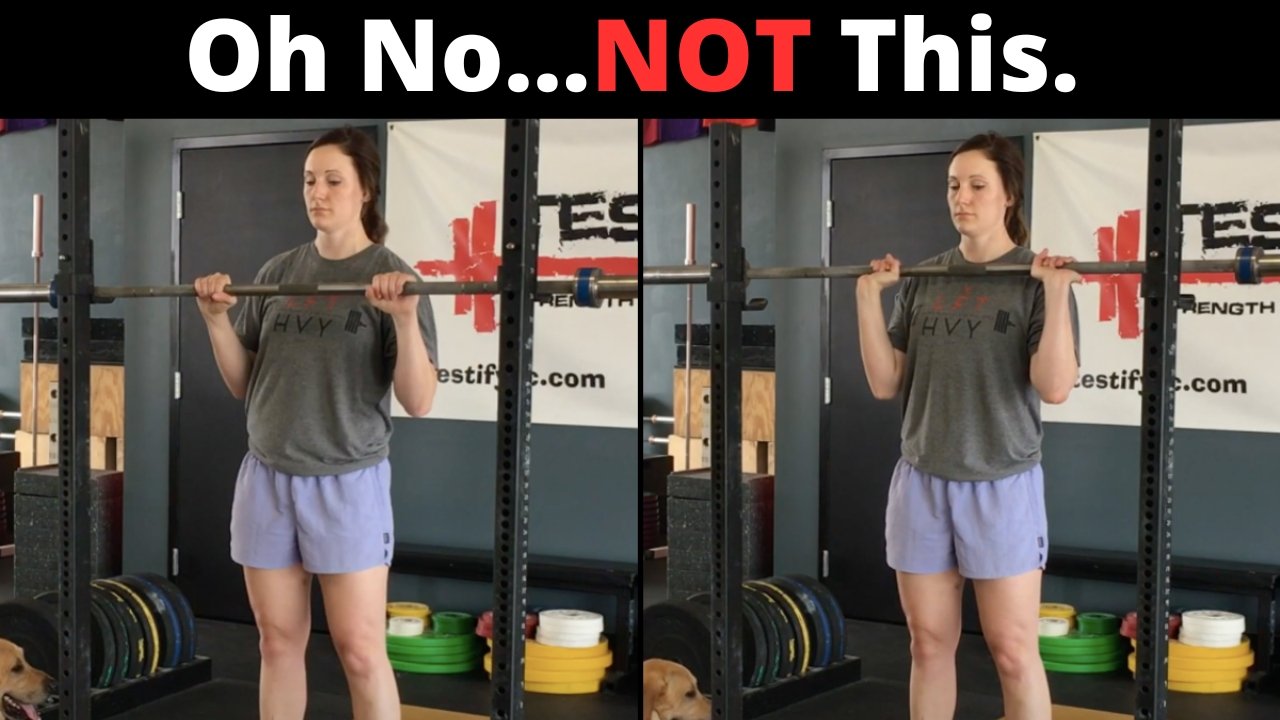Use This Grip for a BIGGER Bench Press and Press!
/Want a bigger bench? A bigger press? Of course you do. Let’s get right to it.
figure 1: Compression grip (bench press configuration)
This article is the first in our short series on the correct grip for each lift - from pushing movements like a bench press or a press to pulling movements like a deadlift or a row, and we’ll also discuss the differences that come into play when you have an Olympic movement like a snatch or clean.
Today’s Topic: Pushing Movements
The grip we are covering today is the type of grip you would take for the bench press (Figure 1), the press, the incline bench press, the close grip bench press, etc. This grip is commonly referred to as a compression grip.
An important concept to remember is that - and this is true for both pushing and pulling movements - gravity alway wants objects to move downward.
This includes the barbell that’s in your hands, so when you’re pushing on the bar, you don’t want to put the bar in a position that permits the bar to accidentally reach a lower position (in your hands) than the position it’s already occupying. In other words, make sure that the bar is in the lowest, stable position you can achieve . . . right from the start.
figure 2: Do not put the bar up here.
What NOT To Do
For example, when you unrack the press, don’t support the barbell up high in the hand (Figure 2). If you do this with a heavy weight, it’s simply going to bend your wrist backward (thus lowering the bar). As a result, your flimsy, little, dainty, baby wrists are in a rather unstable position of extreme extension (Figure 3).
You’ve created an energy leak, and this is not a productive position from which to press or bench heavy weights. What to do?
figure 3: wrists in extreme extension - don’t be like this fool.
Figure 4
The Answer
Before unracking either the press or the bench, get the bar sitting over the base of the palms - not up by the base of your fingers, but at the base of your actual hand (Figure 4).
This position permits the bar to be stacked right over the bones of the forearms, which is excellent for force transfer.
From here, pronate your grip just enough that your thumbs can grip the bar (Figure 5). This positions the thumbs so that they can wrap around the bar in the opposite direction of the rest of your fingers.
Squeeze the bar tightly, and that’s it - this is your grip (Figure 6).
figure 5: pronate the grip slightly until the thumbs are below the bar.
The Result
This grip permits the bar to sit deep in the base of your palm - whether you’re benching or pressing. Your wrists are as straight as they can be, although they won’t be entirely straight - let’s call it a neutral position.
As a side not, wrist wraps can help achieve and maintain this position, but they shouldn’t be a crutch - learn to achieve the correct position without wraps, and then start using wraps as your work weights get heavier.
Figure 6: squeeze the bar tightly.
The wrists certainly are no longer bent back in extreme extension, and they also aren’t so straight that it feels like the bar is pushing down on the webbing of your thumb.
As previously mentioned, the bar is now positioned right over the bones of the forearm (Figure 7), which makes for efficient force transfer between your arms, hands, and the bar, and this makes for a stronger press or bench press.
figure 7: compression grip (press width)
Next up - the tension grip.
As always, we hope these tips help you get stronger and live better.
(Some links may be affiliate links. As an Amazon Associate, Testify earns from qualifying purchases.)
If you found this helpful, you’ll love our weekly email. It’s got useful videos, articles, and training tips just like the one in this article. Sign up below, and of course, if you don’t love it, you can unsubscribe at any time.
At Testify, we offer small group training, private coaching (in-person or remotely via Zoom), online coaching, and form checks. Would you like to get quality coaching from a Starting Strength Coach?
This WEIRD Press Error is A PROBLEM
/Are you making this mistake at the start of your press? If so, it's messing up your press bad, so let's fix it quick.
At Testify, we offer small group training, private coaching (in-person or remotely via Zoom), online coaching, and form checks. Click the button below to get quality coaching from a Starting Strength Coach and start getting stronger TODAY.
How to Unrack the Press: Use Your Legs!
/Figure 1: Becky demonstrates how NOT to unrack the press.
(This is a Blast from the Past article originally posted on 10/08/21.)
A common problem with new lifters and the press is the act of unracking the press. They will often pick up the bar using their arms and their shoulders - in other words, they’re using their upper bodies to unrack the press, which is inefficient and difficult at heavy weights. Let’s fix this.
When you unrack the bar by incorrectly using your arms and shoulders, it looks like what Becky is demonstrating in Figure 1. Notice how she reaches out, grabs the bar with her arms, and tries to pull it back into position.
Also, note that she has her wrists in pretty severe extension (i.e., they are bent backwards), which we don’t want, and her elbows are behind the bar, which we don’t want either. In addition, it’s simply difficult to pick up a heavy press in this manner.
If this was actually a heavy weight instead of the empty bar, Becky might not be able to unrack it at all in this manner, and even if she did, she’d be in a weak position from which to start pressing.
Remember: When you unrack a press, you unrack it with your legs.
Use the following steps:
1. Take your grip. (Figure 2a)
2. Walk right up the bar - your chest may actually touch the bar. (Figure 2b)
Figure 2a (left) and Figure 2b (right)
3. Squat down far enough that your elbows are slightly in front of the bar and you’ve got relatively straight wrists. (Figure 3a)
4. Stand the bar up with your legs. (Figure 3b)
Figure 3a (left) and Figure 3b (right)
Figure 4
5. Step back and establish your stance. (Figure 4)
Remember - unrack the press with your legs. As always, we hope this helps you get stronger and live better!
(Some links may be affiliate links. As an Amazon Associate, Testify earns from qualifying purchases.)
If you found this helpful, you’ll love our weekly email. It’s got useful videos, articles, and training tips just like the one in this article. Sign up below, and of course, if you don’t love it, you can unsubscribe at any time.
At Testify, we offer small group training, private coaching (in-person or remotely via Zoom), online coaching, and form checks. Would you like to get quality coaching from a Starting Strength Coach?
The HIDDEN ERROR in His Press | Two Minute Tactics!
/He's ruining the start position of his press, and it's not why (or where) you think. Find out more and improve your own press.
At Testify, we offer small group training, private coaching (in-person or remotely via Zoom), online coaching, and form checks. Click the button below to get quality coaching from a Starting Strength Coach and start getting stronger TODAY.
Why Your Press is WEAK: Fix Your Unrack and Grip with this Simple Mnemonic Device
/A common problem in the press is a terrible unracking process, and we've covered this before in both videos and articles, but here’s a different take - a simple mnemonic device - that just might help you out.
The Problem
You know you want a neutral wrist when pressing. It shouldn’t be completely straight (although we might use the overcue “straight wrists” at times), but it certainly should not be bent backward in full extension, either. The problem of full extension is the more common of the two errors and is the situation we’re addressing here. For a video demonstration and explanation of this problem as well as how to solve it, be sure to watch one of the included videos.
When It Happens
You’re setting up to take your grip for the press - your grip is relatively narrow, you’ve pronated your hands slightly, and although you know you’re supposed to maintain a rigid, neutral wrist position as you approach and unrack the bar, it’s at this point that everything goes in the crapper. Somehow, as you approached the bar, you allowed your wrists to bend backward into full extension - which is a very weak and inefficient position from which to press - and now your coach wants to gouge his eyes out. Let’s prevent this.
The Culprit
You simply didn’t get low enough to allow yourself to maintain a neutral wrist. Remember that the legs are responsible for unracking the bar correctly - in a manner of speaking, you pick it up with your legs, not your arms. You need to dip down low enough so that you can keep your wrists neutral when approaching and unracking the bar. A decent pair of wrist wraps can help maintain neutral wrists, but they won’t cover up the root problem of not dipping down low enough with your legs.
A Simple Mnemonic Device
“Chest to bar, chin to bar.”
When taking your pronated grip, be sure to squeeze the bar tightly - crush the bar, if you will - then walk your chest up to the bar with your feet directly under the bar. This “chest to bar” aspect ensures you are close enough to the bar. Next, squat down - you’re actually just bending your knees - until the underside of your chin touches the bar.
By doing this, you’ve dipped down far enough that you’ve given yourself sufficient room to maintain a neutral wrist. If you don’t dip down far enough to create that space, your wrists will have to bend backward into extension to allow you to pick up the bar (because bending your wrists backward makes your forearms artificially shorter), and this is what you’re trying to avoid.
That’s all there is to it - simply walk your chest up to the bar, dip down until your chin touches the bar as you rotate your elbows slightly in front of the bar, and then stand the bar up while maintaining that nice, neutral wrist.
As a side note, some people won’t need to dip that far down; “chin to bar” will be overkill in these cases, but it will still work for pretty much everyone.
As always, we hope this helps you get stronger and live better.
(Some links may be affiliate links. As an Amazon Associate, Testify earns from qualifying purchases.)












